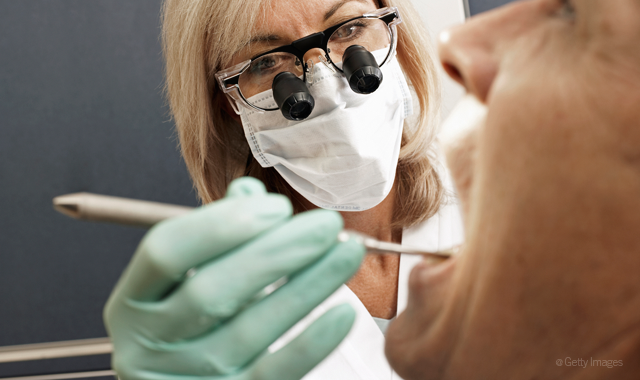Why it’s important to include periodontal probing in a hygiene appointment
Hygienists are often pressed for time, but periodontal exams shouldn’t be overlooked.

The weeks fly by between now and Christmas, and it’s my favorite time of the year. When our children were young, my husband, David, would always carve a pumpkin and it became a family ritual. We’d salt and bake the pumpkin seeds and I was the only one who would eat them!
Periodontal probing has become an adult periodontal exam ritual, and it is part of the comprehensive exam for new and recare adults. Never thought I’d admit this, but I’m really struggling to get it done during the hygiene appointment. Unfortunately, I don’t think I’m alone. We don’t want to rush the periodontal exam and we want it to be accurate. As the marketplace continues to change and as more general dental practices accept discounted fees (35 percent to 45 percent in PPOs), hygienists are being squeezed to see more patients in less time, and it confirms that the clock really is king!1
Most of us would like to have an hour or more for patients, and we enjoy performing periodontal exams, given adequate time, but we are frequently judged on time and how fast we work. New adult and recare adult care intervals are different depending on the practice you find yourself in as is the equipment and technology to support the care you deliver. I have done a lot of temp hygiene days in practices that still use paper charts and where hygiene assistants are still hovering around the dentist.
Trending article: 10 reasons dentists should be thankful for hygienists and assistants
Quantifying loss of periodontal attachment

Before performing a periodontal exam, I tell my patients this: Healthy teeth are desirable, but they must have a healthy infrastructure. You can build a lovely house for your family, but if the foundations are based on sand, it won’t remain lovely for long. I show them a detailed image of the periodontium and point out the gingiva, the periodontal ligament (which I describe as a rubber band that gives the tooth some wiggle room) and the alveolar bone. I also talk about periodontal inflammation but save most of that discussion for a later time because the exam isn’t about inflammatory activity in a periodontal pocket. Instead, I’m measuring the after effect or “sequelae” of previous injury to the periodontium. Severity of bleeding (BOP) and loss of connective tissue attachment (CAL) are just as important as probing depth (PD). The accurate recording of PD and CAL takes time and should not be done without an assistant or a hands-free technology. The Florida Probe, for example, records not only probing depth but CAL, BOP, suppuration, furcation involvement, mobility and even plaque assessment. The Dental R.A.T. is a simple foot-operated mouse that uses our feet to perform periodontal charting in an efficient manner.
These future-generation probes increase reliability of measurements for PD and CAL by applying constant pressure along with eliminating transcription errors.2
For those hygienists who are manual probing without an assistant, there are many factors that affect reliability, including lack of time for thorough measurement and documentation, probe-tip size, angle of insertion of probe, lack of probe calibration and degree of inflammation.2 It has also been reported that deep probing depths are underestimated by manual and automatic probes.2
Up next: Why hygienists should care about photoacoustic imaging...
Photoacoustic imaging
What is photoacoustic imaging and what does it have to do with periodontal probing?
Over the last 10 years, rapid research explorations with applications in photoacoustic imaging have emerged as a promising image technology in biological tissues. Photoacoustics is also an ultrasound technique that has been developed to record probing depths in an efficient and reliable manner. I recently spoke to Jesse Jokerst, a professor of nanoengineering a the University of California San Diego. He talked to me about photoacoustics, and I’d like to explain the science behind the imaging modality (Imaging details can be viewed on YouTube).
Photoacoustic imaging uses squid ink as a contrast agent that the patient rinses with during a procedure where a mouthpiece acts as a transducer and records probing depths throughout the mouth. Keep in mind that this imaging modality is in the early stages of study and human subjects in early clinical trials are now being used to test the modality against traditional probing technique. The mouthpiece is currently being constructed and tested.
Read more: Can dentists use squid ink to check for gum disease?
When a concentrated light source (e.g. a laser) is used to illuminate living tissue in small spaces, the image can be confused because light will be reflected from adjacent and underlying tissue. The photoacoustic technique overcomes this problem by using a pulse of (usually) laser light to create a tiny vibration in the target tissue. The resulting vibration is at a very high frequency (perhaps 20 million cycles per second or a bit less), but is nevertheless ‘acoustic’ in the sense that it can travel through the air. More importantly, it will be only weakly reflected by adjacent tissue so that a clearer image of the target tissue can be obtained. Obviously, a lot of computing power is required in this process.
The squid ink contains melanin nanoparticles, which absorb light. These nanoparticles get absorbed into the pockets and when the transducer in the mouthpiece (laser light) is shined onto the stained periodontium, the squid ink swells and can be quickly detected by ultrasound, which is looking for the little “ping.”
OK, my RDH friends, while waiting for this exciting technology to come to our operatories, make sure you have a dedicated assistant or some kind of automated device available during the periodontal exam to reduce clinician error. I understand your frustration in finding time to probe because, like you, I’m deep in the pocket trenches, too.
References:
http://www.rdhmag.com/articles/print/volume-31/issue-6/features/the-clock-is-king.html
https://www.ncbi.nlm.nih.gov/pmc/articles/PMC4646937/
https://www.ncbi.nlm.nih.gov/pmc/articles/PMC4530316/
https://www.dentalaegis.com/cced/2011/03/periodontal-probing-systems-a-review-of-available-equipment